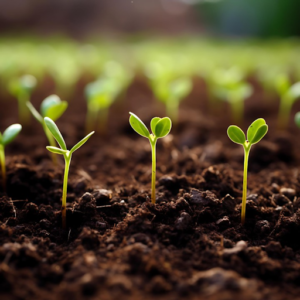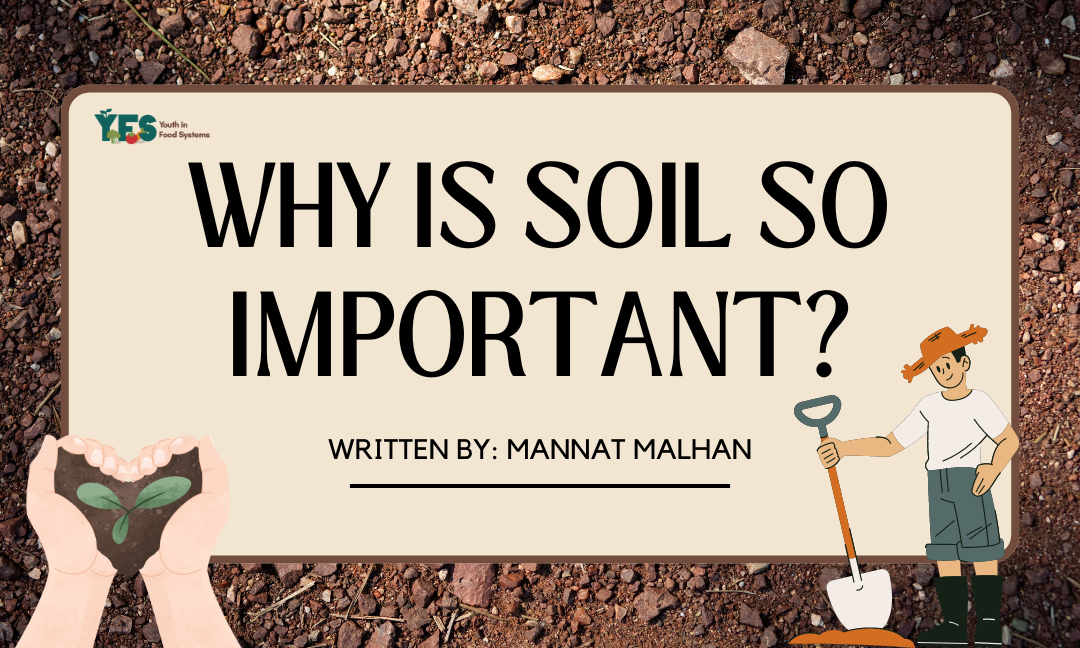Written by: Mannat Malhan
Editd by: Kiritika Rana
Designed by: Sargam
Published by: Maryam Khan
The ground beneath our feet, grows more than 95% of our food, fueling our bodies and souls. Soil plays a vital role in sustaining life on Earth, anchoring roots, storing water, and holding nutrients. It’s not just dirt, but a complex ecosystem that helps plants grow and provides the essential nutrients for agriculture. In this blog, we’re going to look at soil preservation, what soil is, the threats to soil, and what you can do to help.
Let’s start with what soil is. It’s a loose surface covering most land, consisting of organic and inorganic matter, serving as a natural ground for plants to sprout. But it’s becoming less and less fertile because of too much planting and agriculture. Cultivation practices such as deep plowing and heavy tillage weaken the soil and disrupt the structure of the ground. For example, heavy tillage refers to preparing land for crop cultivation, using heavy machinery to mechanically break up the soil and create equal seedbeds for planting. This leads to soil erosion, loss of organic matter, and the soil structure being messed up over time.
 Many factors affect soil health though. These include erosion, chemical fertilizers, pesticides, deforestation, and as mentioned above, industrial cultivation practices. All of these factors lower soil quality, leading to the loss of biodiversity and fertility. The biggest problem that affects soil health is soil erosion. This happens when soil is washed or blown away from the surface, which can be caused by extreme weather events and intensive farming practices. Soil erosion leads to an increase in carbon emissions in the atmosphere since the erosion causes the soil to be displaced and the organic carbon with it. Soil is our largest carbon sink, other than the ocean, because of its ability to store carbon. It has about 2,500 gigatons of carbon held in it, which is three times more carbon than our atmosphere. The soil plays a crucial role in slowing down climate change.
Many factors affect soil health though. These include erosion, chemical fertilizers, pesticides, deforestation, and as mentioned above, industrial cultivation practices. All of these factors lower soil quality, leading to the loss of biodiversity and fertility. The biggest problem that affects soil health is soil erosion. This happens when soil is washed or blown away from the surface, which can be caused by extreme weather events and intensive farming practices. Soil erosion leads to an increase in carbon emissions in the atmosphere since the erosion causes the soil to be displaced and the organic carbon with it. Soil is our largest carbon sink, other than the ocean, because of its ability to store carbon. It has about 2,500 gigatons of carbon held in it, which is three times more carbon than our atmosphere. The soil plays a crucial role in slowing down climate change.
And it’s not like we’re doing anything to reduce soil health, right? No, not, if we’re excluding the fact that we’re releasing 40 billion tonnes from burning fossil fuels, causing animals to go extinct, sea levels to rise and soil to release carbon that it has stored. Do you know that if the Earth keeps heating up, you’ll be able to sail across the North Pole by 2050? That’s how detrimental the effects are. How much are we going to keep using fossil fuels and what will we do when we reach the point of scarcity?
This is where preservation comes into play. The meaning of soil preservation (or conservation), is using methods that prevent erosion and pollution of the soil. It means treating the soil as a living ecosystem because it is one! Practices such as crop rotation, composting and no-till farming all promote preservation. Looking deeper into crop rotation, it’s planting a different crop on a piece of land each growing season. The practice is meant to reduce the reliance of crops on one set of nutrients, pest and weed pressure, along with the possibility of developing resistant pests and weeds.
Composting is easy enough, right? It’s an easy way to turn waste into useful materials. When composting happens, many types of bacteria, fungi, and insects naturally habit the soil, breaking down the material in an aerobic condition, which is a process done with little oxygen present. You can compost many things in your home, such as vegetable/fruit peelings, coffee grounds, newspaper, paper towels, and egg shells; all compostable items! Composted food scraps can significantly improve soil quality, fertility, and tilth,
which all benefit urban farmers to grow more local and low-cost vegetables.
 Have you ever heard about how the smallest things count? Yeah, well that applies to soil too. If you were to plant seeds in your garden, the root would grow down into the soil to absorb the nutrients and anchor to the ground. The roots give water and minerals from the soil to the plant. Not only that, the roots serve as an anchor and they help reduce soil erosion. They can increase the strength and water stability of the soil as well.
Have you ever heard about how the smallest things count? Yeah, well that applies to soil too. If you were to plant seeds in your garden, the root would grow down into the soil to absorb the nutrients and anchor to the ground. The roots give water and minerals from the soil to the plant. Not only that, the roots serve as an anchor and they help reduce soil erosion. They can increase the strength and water stability of the soil as well.
We must take steps to preserve and protect soil health. The easiest thing you can do is compost or grow your garden. But, bigger steps would be reducing the amount of soil lost to erosion. This can be achieved by implementing better land use practices, such as reducing intensive farming and using no-till techniques. Reducing the use of pesticides and controlling what amount goes into the soil will also promote more sustainable farming practices, improving the soil and supporting wildlife and biodiversity.
So, in a few words, soil might look like a dirty and messy substance, but it’s a remarkable treasure. It’s a home for plants to grow and supports a diverse ray of life, including fungi, bacteria, and insects. Soil makes the world a better place for us and the animals that live here, but it’s upsetting how we don’t treat it well. Realizing how important soil is, and doing our part to protect and preserve it will make a better future for those who are here right now and those who will come after.
Bibliography (Works Cited)
Mantel, S. (2022). Why are soils important? Www.isric.org. https://www.isric.org/discover/about-soils/why-are-soils-important
Zurich. (2022). Why soil is important to life on Earth – and helps fight climate change. Zurich.com. https://www.zurich.com/en/media/magazine/2021/how-soil-supports-life-on-earth-and-could-help-win-the-fight-against-climate-change
Glasener, Karl. Ecosystems Services. 2013. https://www.soils.org/files/science-policy/sssa-marketing-2013.pdf
Soil, land and climate change — European Environment Agency. (2019). Www.eea.europa.eu. https://www.eea.europa.eu/signals-archived/signals-2019-content-list/articles/soil-land-and-climate-change
Cho, Renee. “Can Soil Help Combat Climate Change?” State of the Planet, Columbia Climate School, 21 Feb. 2018, news.climate.columbia.edu/2018/02/21/can-soil-help-combat-climate-change/.
What Are Different Types of Tillage Systems? (2023, February 17). Kelly Tillage USA. https://kellytillage.com/us/what-are-different-types-of-tillage-systems/#:~:text=Intensive%20tillage%20refers%20to%20a
Why Soil Matters (and what we can do to save it). (2017, November 1). Environment. https://www.nationalgeographic.com/environment/article/paid-content-why-soil-matters-and-what-we-can-do-to-save-it#:~:text=Soil%20is%20fundamental%20to%20all
Soil Conservation. (n.d.). Www.johnstonnc.com. https://www.johnstonnc.com/swc/content.cfm?pageid=wisc#:~:text=Soil%20Conservation%20is%20a%20combination
Hu, Shelia. “Composting 101.” NRDC, NRDC, 20 July 2020, www.nrdc.org/stories/composting-101.
Maryville University. “Soil Conservation Guide: Importance and Practices.” Maryville Online, 26 Feb. 2021, online.maryville.edu/blog/soil-conservation/.

